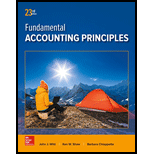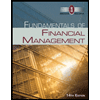
Concept explainers
Problem 14-11EC
Capital lease accounting
C3
Braun Company signs a ?ve-year capital lease with Verdi Company for office equipment. The annual year-end lease payment is $20,000, and the interest rate is 10%.
Required
1. Compute the present value of Braun’s lease payments.
2. Prepare the
3. Complete a lease payment schedule for the ?ve years of the lease with the following headings. Assume that the beginning balance of the lease liability (present value of lease payments) is $75,816. (Hint: To ?nd the amount allocated to interest in year 1, multiply the interest rate by the beginning-of year lease liability. The amount of the annual lease payment not allocated to interest is allocated to principal. Reduce the lease liability by the amount allocated to principal to update the lease liability at each year-end.)
4. Use straight-line
Check (1) $75,816
(3) Year 3 ending balance $34,712
| Period Ending Date | Beginning Balance of Lease Liability | Interest on Lease Liability | Reduction of Lease Liability | Cash Lease Payment | Ending Balance of Lease Liability |
1)
Introduction:
Present value of lease payments:
• Leasing is an arrangement between two parties whereby one party known as the lessor, rents goods or right to use goods for a period of time that is predetermined and the other party, known as the lessee, pays a rent called Lease Rent.
• The present value of lease payments is calculated to analyze the cost borne to lease the goods or services and is a calculation of the lease rent paid over the lifetime translated into equivalent costs as if it was paid today.
To Determine:
Present value of lease payments.
Answer to Problem 11BPSB
Solution:
The present value of lease payments is $ 75,816.
Explanation of Solution
Given:
Annual Lease Rent = $20,000
Number of years = 5 years
Interest rate = 10% per annum
Formula used:
Calculation:
• The present value is calculated to analyze the cost of leasing the asset and computing its value as if the lease payments were to be made today.
• Usually the fair value of the assets matches the present value of the lease payments, and this is an indicator of whether the lease rent is fair or overvalued.
• The lease rents comprise of interest component and hence while calculating the present value of lease payments, the interest rate is used to discount the lease rent.
Hence the present value of lease rent is computed.
2)
Introduction:
Journal Entries
• Journal entries are the first step in recording financial transactions and preparation of financial statements.
• These represent the impact of the financial transaction and demonstrate the effect on the accounts impacted in the form of debits and credits.
• Assets and expenses have debit balances and Liabilities and Incomes have credit balances and according to the business transaction, the accounts are appropriately debited / credited to reflect the effect of business transactions and events.
To Determine:
Journal entry to record Capital Lease at inception.
Answer to Problem 11BPSB
Solution:
| Date | Particulars | Debit ($) | Credit ($) |
| 12.31.XXXX | Office Equipment | 75,816 | |
| Lease liability Payable | 75,816 | ||
| (Being capital lease on office equipment recorded at inception) |
Explanation of Solution
• The present value of lease payments is recorded as the value of the assets taken on lease. This is the fair value / cost of acquisition of right to use of the assets.
• The lease liability is the present value of lease calculated using the following formula:
• Assets and Expenses have debit balances and must be debited in order to increase their balance and credited in order to decrease their balance.
• Liabilities and Incomes have credit balances and must be debited in order to decrease their balance and credited in order to increase their balance.
• Office equipment is an asset and must be debited in order to establish the asset. Lease liability is a liability and hence must be credited in order to record the liability at inception.
Hence the transaction of recording the capital lease at inception is journalized.
3)
Introduction:
Present value of lease payments:
• Leasing is an arrangement between two parties whereby one party known as the lessor, rents goods or right to use goods for a period of time that is predetermined and the other party, known as the lessee, pays a rent called Lease Rent.
• The present value of lease payments is calculated to analyze the cost borne to lease the goods or services and is a calculation of the lease rent paid over the lifetime translated into equivalent costs as if it was paid today.
To Calculate:
Lease Repayment schedule for 5 years
Answer to Problem 11BPSB
Solution:
| Period Ending Date | Beginning Balance of Lease Liability | Interest on Lease Liability | Reduction of Lease Liability | Cash Lease Payment | Ending Balance of Lease Liability |
| 2018 | $ 75,816.00 | $ 7,581.60 | $ 12,418.40 | $ 20,000.00 | $ 55,816.00 |
| 2019 | $ 63,397.60 | $ 6,339.76 | $ 13,660.24 | $ 20,000.00 | $ 49,737.36 |
| 2020 | $ 49,737.36 | $ 4,973.74 | $ 15,026.26 | $ 20,000.00 | $ 34,711.10 |
| 2021 | $ 34,711.10 | $ 3,471.11 | $ 16,528.89 | $ 20,000.00 | $ 18,182.21 |
| 2022 | $ 18,182.21 | $ 1,818.22 | - | $ 20,000.00 | - |
Explanation of Solution
• Beginning Balance of Lease Liability is the present value of the lease payments over the lifetime of the lease agreement. It is computed based on the interest rate and annual lease payments.
• Interest on Lease Liability is computed by calculating the interest rate on the beginning balance of the lease liability outstanding. The interest reduces over time as the principal reduces.
• Reduction of Lease Liability is the difference between the Cash lease payment and the Interest on lease liability. It signifies the principal portion of the lease liability repaid.
• Cash Lease Payment is the annual cash lease rent paid. It consists of both interest and principal.
• Ending Balance of Lease Liability is the difference between the opening balance of the lease liability and the Reduction of Lease Liability. It signifies the principal portion of the lease liability outstanding.
Hence the lease repayment schedule is prepared.
4)
Introduction:
Depreciation
• Depreciation is the expense of wear and tear of assets owing to their usage over the lifetime of the assets. It signifies the reduction in value of assets over the useful life of the asset.
• There are two methods of calculating depreciation Straight line method where the asset is depreciated equally over its useful life.
• The other method is the written down value or reducing balance method, whereby the assets are depreciated over their useful life by a fixed percentage every year calculated on the opening balance.
Journal Entries
• Journal entries are the first step in recording financial transactions and preparation of financial statements.
• These represent the impact of the financial transaction and demonstrate the effect on the accounts impacted in the form of debits and credits.
• Assets and expenses have debit balances and Liabilities and Incomes have credit balances and according to the business transaction, the accounts are appropriately debited / credited to reflect the effect of business transactions and events.
To Determine:
Journal entry to record depreciation of the assets on straight line basis.
Answer to Problem 11BPSB
Solution:
| Date | Particulars | Debit ($) | Credit ($) |
| 12.31.2019 | Depreciation Expense | 15,163 | |
| Accumulated Depreciation | 15,163 | ||
| (Being depreciation expense on office equipment recorded) |
Explanation of Solution
• The present value of lease payments is recorded as the value of the assets taken on lease. This is the fair value / cost of acquisition of right to use of the assets.
• Assets are depreciated over a period of 5 years on a straight line basis. Depreciation is calculated as follows:
• Assets and Expenses have debit balances and must be debited in order to increase their balance and credited in order to decrease their balance.
• Liabilities and Incomes have credit balances and must be debited in order to decrease their balance and credited in order to increase their balance.
• Depreciation Expense is an expense and has a debit balance and must be debited to indicate increase in expense. Accumulated Depreciation is a liability and must be credited to indicate increase in liability.
Hence the transaction to depreciate the assets has been journalized.
Want to see more full solutions like this?
Chapter 14 Solutions
Fundamental Accounting Principles
 Financial Accounting: The Impact on Decision Make...AccountingISBN:9781305654174Author:Gary A. Porter, Curtis L. NortonPublisher:Cengage Learning
Financial Accounting: The Impact on Decision Make...AccountingISBN:9781305654174Author:Gary A. Porter, Curtis L. NortonPublisher:Cengage Learning Fundamentals of Financial Management (MindTap Cou...FinanceISBN:9781285867977Author:Eugene F. Brigham, Joel F. HoustonPublisher:Cengage Learning
Fundamentals of Financial Management (MindTap Cou...FinanceISBN:9781285867977Author:Eugene F. Brigham, Joel F. HoustonPublisher:Cengage Learning Fundamentals of Financial Management (MindTap Cou...FinanceISBN:9781337395250Author:Eugene F. Brigham, Joel F. HoustonPublisher:Cengage Learning
Fundamentals of Financial Management (MindTap Cou...FinanceISBN:9781337395250Author:Eugene F. Brigham, Joel F. HoustonPublisher:Cengage Learning Intermediate Accounting: Reporting And AnalysisAccountingISBN:9781337788281Author:James M. Wahlen, Jefferson P. Jones, Donald PagachPublisher:Cengage Learning
Intermediate Accounting: Reporting And AnalysisAccountingISBN:9781337788281Author:James M. Wahlen, Jefferson P. Jones, Donald PagachPublisher:Cengage Learning



